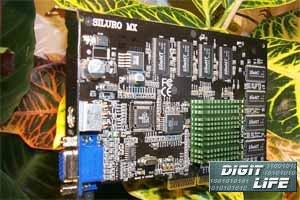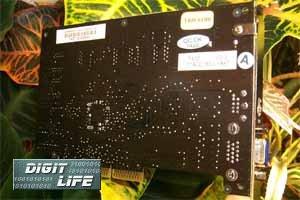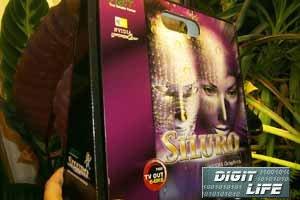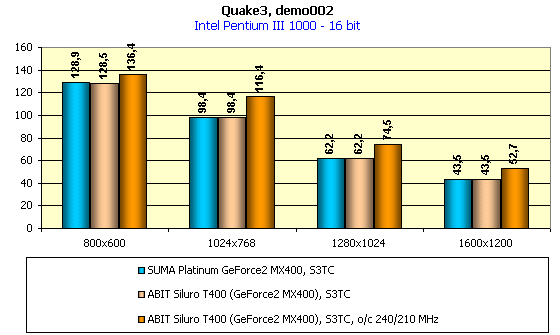 |
||
|
||
| ||
 NVIDIA GeForce2 MX cards have been selling nearly a year already, and their prices have dropped so significantly that these cards has become very popular. There are a lot of versions of these products: a wide range of frequencies, a trimmed memory exchange bus. You may also notice a cheap trick of installation of 64 MBytes video memory on such cards. When a graphics processor chokes with lack of the memory bandwidth on its rated modes, then it doesn't need such volume of this slow memory. But such a super-size of the RAM is preferable for the marketing. It is better to set more memory but not the cheapest which hardly works on its rated frequencies. Now even GeForce2 MX200 cards are equipped with the same size of 64 MB! A card which is capable to work a maximum of the speed of Riva TNT2Pro, for which a 32-bit color is useless, is given a 64 MBytes RAM! Thanks God there are rational ideas and rational realizations. As you know the fastest among GeForce2 MX's is GeForce2 MX400. And such a memory size will suit only these cards. Many companies have taken exactly this way, for example, Leadtek has no one MX400 with 32 MBytes of memory, so does ABIT, which now produces not only mainboards but also a series of video cards named Siluro. Some time ago we already examined one of the MX cards from this company. ABIT Computer releases new models not often. But the company didn't refuse to produce new MXs, and today we are dealing with one of MX200/MX400 solutions from ABIT. CardThe ABIT Siluro T400 card has AGP x2/x4 interface, 64 MBytes SDR SDRAM located in 8 chips on the right side of the PCB.    EliteMT produces the memory chips with a 6 ns access time which corresponds to 166 MHz. The memory works right at this frequency. I've already mentioned that for such size of RAM the manufacturers equip their cards with a slower memory at the expense of its operation speed. It is known that for MX400 cards NVIDIA recommends 200/183 MHz. But we are coming across such situation the second time already (the first was connected with the Leadtek WinFast GeForce2 MX MAX) and again you can see that the MX400 is equipped not with 5.5 ns but with 6 ns memory. The design is rather simple, the PCB is dark brown. On the card you can find a TV-out with a S-Video connector, but the card is supplied with an S-Video-to-RCA adapter, that is why if your video equipment has no S-Video connectors, you can use the TV-out. A passive heat sink with plate fins is attached to the GPU. It seems that the ABIT's engineers are not afraid of overheating of the GeForce2 MX400, which works at a higher frequency than a usual GeForce2 MX (the ABIT Siluro MX had yet an active heat sink).  The card ships in a bag-shaped Retail package, where you can find:
Overclocking The ABIT Siluro T400 was overclocked up to 240/210 MHz. It is not a record among similar cards, but it is not a fault of the card: the drivers are to be blamed. Unfortunately, all latest versions of the Detonators do not detect correctly a frequency the memory operates at if 16-bit chips are used to provide the required size (either 4 pieces for the MX200 cards or 8 pcs for the MX400 cards with 64 MBytes of RAM). The user receives a double frequency as if DDR memory is installed. As a result, overclocking of the memory is severely limited, and even the latest version of the RivaTuner doesn't allow jumping over 400, i.e. 200 MHz for the memory. Only the utility coming with the video card (Graphic MAX) can help in reaching of 210 MHz. By the way, this error is corrected in the new version of the Graphic MAX, where a user can see real frequencies. It should be noted, however, that 210 MHz is a good result for 6 ns memory. But taking into consideration that memory from EliteMT always had an excellent overclocking potential, I wish the software had allowed lifting the frequency some more. Installation and driversTest system configuration:
In the tests we used the NVIDIA v.12.60 drivers, S3TC was enabled, VSync was disabled. For the comparative analyses we used the results of the SUMA Platinum GeForce2 MX400 PowerUp video card (200/183 MHz). Test resultsThe 2D graphics shows nothing to make me angry. As you might remember, the previous Abit's card on the NVIDIA GeForce2 MX had far not excellent image quality. Here the image is marvelous up to 1280X1024X100 Hz. But the quality depends not only a manufacturer of a video card, but also on a definite sample. For estimation of the performance in the 3D we used an id Software Quake3 v.1.17 test which demonstrates the card's operation in the OpenGL with a standard demo002 benchmark used. Quake3 Arenademo002The test was carried out in two modes: Fast (in 16-bit color) and High Quality (in 32-bit color).   The ABIT Siluro T400 performs not worse than its competitor, and overclocking makes the definite contribution. ConclusionIt is an ordinary card of the GeForce2 MX400 class, which is equipped with excessive memory. On the other hand, the card has high-quality memory, ships in an attractive box and costs not much than many noname cards of this class. For the complete comparison characteristics of video cards of this and other classes refer to our 3Digest. Highs:
Lows:
Write a comment below. No registration needed!
|
Platform · Video · Multimedia · Mobile · Other || About us & Privacy policy · Twitter · Facebook Copyright © Byrds Research & Publishing, Ltd., 1997–2011. All rights reserved. |